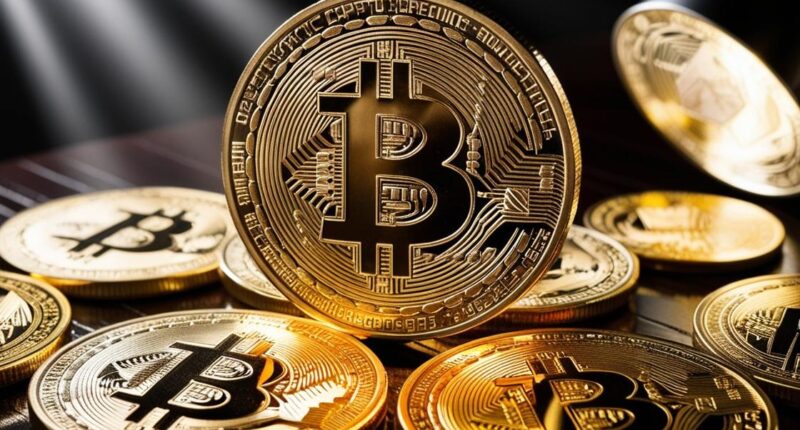Centralized coins are digital assets managed by a single organization, which controls the majority of their supply. These coins, such as Ripple (XRP) and Binance Coin (BNB), allow for quicker transaction processing and scalability compared to decentralized cryptocurrencies. Their centralized nature means that decision-making is more streamlined, but it also raises concerns about security, censorship, and trust in the entity controlling the coin. Understanding their advantages and disadvantages is essential for informed cryptocurrency choices, as further insights will be explored.

Centralized coins in cryptocurrency represent a category of digital assets that are mainly controlled by a single entity or organization. These coins are typically characterized by a majority of the coin supply being owned by their creators or a small group. Centralized decision-making governs their development and operations, which often leads to a more streamlined process for implementing changes and upgrades. Many centralized coins are pre-mined before being released to the public, setting them apart from decentralized cryptocurrencies like Bitcoin, which rely on a broader distribution model.
Centralized coins are digital assets controlled by a single entity, streamlining development and operations through centralized decision-making.
Examples of centralized coins include Ripple (XRP), which is mainly owned by the Ripple company, and Binance Coin (BNB), created and controlled by the Binance exchange. Tether (USDT) is another example, as it is a stablecoin managed by Tether Limited. Additionally, Stellar (XLM) has a significant portion held by the Stellar Development Foundation, while Cardano (ADA) is developed and governed by the IOHK company. Centralized coins often have higher liquidity compared to decentralized alternatives, making them more accessible for large trades. Centralized exchanges also facilitate fiat to cryptocurrency exchanges, enhancing the usability of centralized coins. Moreover, these coins can play a significant role in XRP-backed securities, providing liquidity and facilitating transactions within the financial ecosystem.
The advantages of centralized coins include faster transaction processing times and improved scalability. Their centralized nature allows for easier implementation of upgrades, aligning them more closely with regulatory requirements, which can facilitate institutional adoption. A dedicated team often supports these coins for development and marketing, increasing the potential for partnerships with traditional businesses.
However, centralized coins also present certain disadvantages. A single point of failure exists if the controlling entity is compromised, making them less resilient to censorship or interference. This lack of true decentralization can lead to concerns regarding manipulation, as users must place their trust in the issuing organization.
With regard to regulatory considerations, centralized coins are more likely to comply with government regulations, often requiring KYC (Know Your Customer) and AML (Anti-Money Laundering) procedures. They may also be classified as securities in some jurisdictions, exposing them to potential crackdowns.
Frequently Asked Questions
How Do Centralized Coins Differ From Decentralized Coins?
Centralized coins differ from decentralized coins in several key aspects.
Centralized coins are controlled by a single entity, allowing for unilateral changes to their protocols, while decentralized coins require consensus among users for any modifications.
Token distribution also varies; centralized coins often have large pre-mines, whereas decentralized coins distribute tokens more widely.
Additionally, centralized coins rely on company servers, making them more vulnerable to attacks, while decentralized coins benefit from a distributed network, enhancing security.
What Are the Main Advantages of Using Centralized Coins?
The main advantages of using centralized coins include ease of use and accessibility, as they often feature user-friendly interfaces and simple account verification processes.
Additionally, they provide high liquidity and trading volume, leading to faster trade execution and lower spreads.
Enhanced security measures, such as KYC and cold storage, protect user assets.
Finally, advanced trading features, including margin trading and multiple order types, cater to both novice and experienced traders, improving overall user experience.
Can Centralized Coins Be Converted to Decentralized Coins?
Centralized coins can indeed be converted into decentralized coins.
This process typically involves using token swapping protocols or cross-chain bridges. Users may need to utilize decentralized exchanges or wrapped tokens to facilitate the conversion.
Regulatory considerations, such as KYC/AML requirements, may apply, varying by jurisdiction.
Additionally, market factors like liquidity and price volatility can influence the ease and timing of these conversions, impacting overall user experience and transaction efficiency.
Are Centralized Coins Regulated by Governments?
Centralized coins are regulated by various governments, with regulations differing greatly by country.
In the United States, the SEC often classifies them as securities, while the European Union has introduced the MiCA regulation to create a framework for oversight.
Countries like China have banned centralized exchanges entirely, whereas Japan mandates registration with its Financial Services Agency.
Common regulatory requirements include KYC/AML procedures, transaction record maintenance, and cybersecurity measures to protect users and guarantee compliance.
What Happens if a Centralized Coin Issuer Goes Bankrupt?
If a centralized coin issuer goes bankrupt, customer assets may become part of the bankruptcy estate.
This situation complicates ownership claims, especially if funds were commingled. Courts will need to determine whether customers retain ownership rights based on agreements with the issuer.
Additionally, withdrawals made within 90 days before bankruptcy could be subject to clawbacks, placing further uncertainty on the recovery of funds and the valuation of assets during the proceedings.
References
- https://www.rapidinnovation.io/post/what-are-centralized-cryptocurrency-exchanges
- https://www.investopedia.com/tech/what-are-centralized-cryptocurrency-exchanges/
- https://masterthecrypto.com/understanding-impacts-of-centralization/
- https://www.experian.com/blogs/ask-experian/centralized-vs-decentralized-crypto-exchanges/
- https://www.investopedia.com/terms/c/cryptocurrency.asp
- https://usa.kaspersky.com/resource-center/definitions/what-is-cryptocurrency
- https://zenledger.io/blog/decentralized-exchange-vs-centralized-exchange/
- https://honors.umkc.edu/documents/lucerna-vol18.pdf
- https://komodoplatform.com/en/academy/centralized-vs-decentralized-exchanges/
- https://cointelegraph.com/learn/articles/centralized-vs-decentralized-crypto-exchanges









